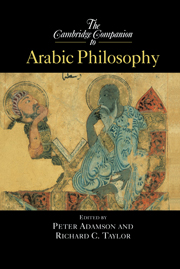Book contents
- Frontmatter
- 1 Introduction
- 2 Greek into Arabic
- 3 Al-Kindī and the reception of Greek philosophy
- 4 Al-Fāarābī and the philosophical curriculum
- 5 The Ismāīlīs
- 6 Avicenna and the Avicennian Tradition
- 7 Al-Ghazālī
- 8 Philosophy in Andalusia
- 9 Averroes
- 10 Suhrawardī and Illuminationism
- 11 Mysticism and philosophy
- 12 Logic
- 13 Ethical and political philosophy
- 14 Natural philosophy
- 15 Psychology
- 16 Metaphysics
- 17 Islamic philosophy and Jewish philosophy
- 18 Arabic into Latin
- 19 Recent trends in Arabic and Persian philosophy
- Select bibliography and further reading
- Index
14 - Natural philosophy
Published online by Cambridge University Press: 28 May 2006
- Frontmatter
- 1 Introduction
- 2 Greek into Arabic
- 3 Al-Kindī and the reception of Greek philosophy
- 4 Al-Fāarābī and the philosophical curriculum
- 5 The Ismāīlīs
- 6 Avicenna and the Avicennian Tradition
- 7 Al-Ghazālī
- 8 Philosophy in Andalusia
- 9 Averroes
- 10 Suhrawardī and Illuminationism
- 11 Mysticism and philosophy
- 12 Logic
- 13 Ethical and political philosophy
- 14 Natural philosophy
- 15 Psychology
- 16 Metaphysics
- 17 Islamic philosophy and Jewish philosophy
- 18 Arabic into Latin
- 19 Recent trends in Arabic and Persian philosophy
- Select bibliography and further reading
- Index
Summary
Natural philosophy, or physics, occupies an ambiguous position in the encyclopedia of ancient learning. It is primarily an ontology of the sensible world, and is thus inseparable from metaphysics. Aristotle’s physical inquiries, for example, can only be understood in the light of the discussions of substance, potentiality, unity, and the Prime Mover that we find in his Metaphysics. But natural philosophy is not only an ontology of the sensible world. It does not aim solely at explaining what we might call the “semantics” of the sensible world. It also tries, in some cases, to set up “syntactic” rules that allow us to describe a given idealized category of phenomena. The contrast between ontology and mathematical physics is an example. But as we shall shortly see, the “syntax” need not be mathematical.
In classical Islam, there was a multiplicity of physical theories. We may mention, among others, the atomism of the “rational theologians” (mutakallimīn), Avicennian neo-Aristotelianism, Averroist “orthodox” Aristotelianism, and the infinitesimalism of some geometers. Does that mean that any effort to distinguish unitary features of a single natural philosophy is doomed to fail? On the contrary, although there was a multiplicity of schools, the physical debate was nonetheless focused on certain fundamental problems. This means not only that certain questions were recognized as particularly significant by all the schools, but also that the answers proposed to them proceeded from some basic intuitions that were held in common. These shared intuitions may thus be viewed as typical of the classical period, even if points of disagreement were more evident to those embroiled in the controversy.
- Type
- Chapter
- Information
- The Cambridge Companion to Arabic Philosophy , pp. 287 - 307Publisher: Cambridge University PressPrint publication year: 2004
- 2
- Cited by

